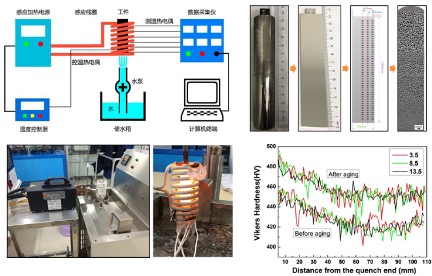Integrated System for High-throughput
Metal Preparation and Performance Prediction
Fanchao Meng1,Wenkai Deng2,Zaiwang Huang2,Shangzhou Zhang1,Liang Jiang1*
1
Yantai University, Yantai, Shandong Province 264005,
China;
2
Central South University, Changsha,
Hunan Province 410083
ABSTRACT: An integrated system for metal preparation and
performance prediction has been developed. The system can simulate the cooling
process of metals at different cooling rates, prepare alloy materials with
microstructure gradient distribution, and rapidly study cooling
rate-microstructure- performance-residual stress relationship on a single
sample, so as to quickly screen the material preparation process and optimize
the characteristics of materials, processes and components. It can be applied
to accurately and efficiently develop high-performance materials and components.
In this system, several thermocouples were used to measure the temperature
curves of different regions in the end quenching process, and then the
temperature curves of samples without phase transformation and with phase
transformation are simulated by software. In addition, the system integrates
the end quenching analysis method and computer simulation, establishes a
high-throughput metal end quenching platform, forms a set of efficient and
accurate data acquisition method of metal properties in the quenching process,
which can effectively obtain the material
composition-process-microstructure-performance relationship. In this report,
the powder metallurgy nickel-based superalloy was taken as the research object,
and the end quenching gradient cooling heat treatment is adopted to realize the
continuous change of solution cooling rate in a large range on a single sample,
and the gradient distribution of γ′ strengthening phase structure was obtained.
Using this method, the microstructure of different heat treatment processes can
be obtained quickly. The effect of heat treatment on the microstructure of the
alloy was systematically studied by means of finite element simulation of
temperature field, thermodynamic and kinetic calculation and microstructure
characterization. Based on the classical precipitation strengthening model,
Nava model and probabilistic cutting model, a new multi peak distribution
strength superposition model of γ′ phase size was proposed. Combining with
solution strengthening and grain boundary strengthening models, the room
temperature yield strength of alloys with different microstructures was
predicted, and the quantitative relationship between process- structure- properties
of nickel-based superalloy was established.

Keywords: Material genetic engineering; high-throughput preparation; composition-process -microstructure-performance relationship; integrated computational material engineering; high-end equipment

Fanchao Meng, received his PhD degree from McGill University, and thereafter worked as a senior engineer at BGI Research Institute, Shenzhen. He is now an associate professor at Yantai University. His research is in integrated computational materials engineering. He has published more than 30 SCI papers in journals such as Journal of the Mechanics and Physics of Solids, Scripta Materialia, Journal of Physical Chemistry Letters, Carbon, etc. He has been awarded the Chinese government award for outstanding self-financed students abroad, and served as reviewers for Materials and Design, Journal of Alloys and Compounds, Surface and Coatings Technology, etc.